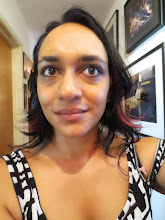
Projective 2, 2007
Shah began her transition from architecture to art shortly after 9/11, when she found herself considering her Muslim faith and Pakistani identity afresh in the wake of the tragedy. She felt compelled to create a body of work which she titled Jihad Pop, in which the Qaaba, the holiest site in Islam, took on a second identity as a Minimalist black cube. As she continued to draw a series of progressions, this cube form expanded, collapsed and multiplied. As the work evolved formally, she began to broaden her visual cues beyond her own personal points of reference, incorporating the Christian cross and the Hindu lotus, for example.

Form Studies, 2007
More recently, Shah has begun to incorporate photographic records of the British colonization of India/Pakistan, which ultimately led to those two countries' separation during the shared national trauma referred to as Partition. This line of inquiry resonates strongly with me, as my own grandparents were displaced by Partition due to religious violence which affected Hindus and Muslims equally. The new project has led her to research the period both in England and in India, where she will spend much of this fall.
Seher Shah's work will be shown at Green Cardamom in London later this year.

